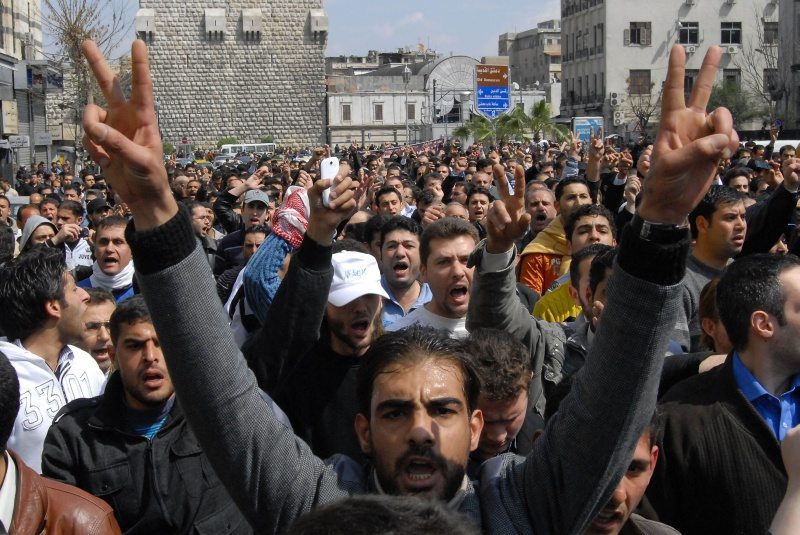Syria said its troops seized a rebel-held Aleppo district on Wednesday after storming it and “annihilating” most of the insurgents, as a long-threatened ground assault on the key city was launched.
The rebels promptly denied the claim, acknowledging that a “barbaric and savage attack” on the neighbourhood of Salaheddin was under way but later saying they had recaptured much of what they lost.
The offensive came as Amnesty International raised concerns about the plight of civilians in Syria’s commercial capital and warned both sides they would be held accountable for attacks on residential areas.
Early in the afternoon, state news agency SANA said “our brave armed forces have taken full control of the district of Salaheddin” and “inflicted heavy losses on groups of armed terrorists, killing or wounding a large number of them.”
Dozens of rebels were captured, including foreigners, and others surrendered, SANA said. It said troops seized a large number of arms.
State television said the “armed forces dealt violent blows to the mercenary terrorists” in Salaheddin, “annihilating most of the terrorists.”
But rebel Free Syrian Army (FSA) spokesman Colonel Abdel Jabbar al-Oqaidi said: “It is not true the regime army has seized control of the district.
“It is true that there is a barbaric and savage attack,” he told AFP via Skype. “They are using all the weapons at their disposal to attack Salaheddin, including fighter jets, tanks and mortars.”
He said there was fighting in many districts, but it was concentrated on Salaheddin because of the “great symbolic value for us and the army.”
Hours later, rebel commander Wassel Ayub said the FSA had launched a counter-attack and retaken part of Salaheddin.
“For an hour and a half, the Free Syrian Army has staged a counter-attack and reclaimed three streets out of five seized by regime forces,” he told AFP by telephone.
“We staged our counter-attack after 700 fighters arrived from the southern neighbourhood of Sukkari, Bustan al-Qasr, Shaar and Hanano” in the east, said Ayub, who heads the Nur al-Haq Brigade.
The Syrian Observatory for Human Rights likewise said the rebels were making gains.
“Clashes also raged in Aleppo’s Al-Midan district as rebels tried to seize” an air force security bureau, the Britain-based watchdog said.
At least 37 people were killed in Aleppo — 17 civilians, 10 rebels and 10 soldiers — from a total of at least 162 nationwide, it said.
“I believe the real number is much higher but it is impossible to document the figures because of the ferocity of the clashes” in Aleppo, Observatory director Rami Abdel Rahman said.
A total of 225 people — mostly civilians — died in Syria on Tuesday, one of the worst days for casualties in the nearly 17-month uprising the Observatory said last week has cost more than 21,000 lives.
— Use of heavy weapons —
————————–
Amnesty showed satellite images indicating an apparent increased use of heavy weapons in the Aleppo area, and warned forces loyal to President Bashar al-Assad and rebels that attacks on civilians would not go unpunished.
“Amnesty International is sending a clear message to both sides in the fighting: any attacks against civilians will be clearly documented so that those responsible can be held accountable,” Amnesty’s Christoph Koettl said.
The London-based watchdog said images from Anadan, a small town near Aleppo, revealed more than 600 probable artillery impact craters from the fierce fighting over the city.
It said a July 31 image showed what seemed to be impact craters next to what appeared to be a residential housing complex in Anadan.
Amnesty said it was concerned the deployment of heavy weaponry in residential areas would lead to further human rights abuses and breaches of international law.
On Tuesday, Assad vowed to crush the rebellion that erupted in March 2011.
“The Syrian people and their government are determined to purge the country of terrorists and to fight the terrorists without respite,” he was quoted by SANA as telling a visiting Iranian envoy, using his regime’s terminology for rebels.
Assad earlier appeared on television for the first time in more than two weeks in greeting Saeed Jalili, a top aide to Iran’s supreme leader Ayatollah Ali Khamenei.
Jalili said Tehran would “never allow the resistance axis — of which Syria is an essential pillar — to break.
“What is happening in Syria is not an internal issue but a conflict between the axis of resistance on the one hand, and the regional and global enemies of this axis on the other,” he said.
On Wednesday, Iranian Foreign Minister Ali Akbar Salehi acknowledged that retired members of the Revolutionary Guards and army were among 48 Iranians taken hostage in Syria by rebels.
“A number of the (hostages) are retired members of the Guards and the army. Some others were from other ministries,” Salehi was quoted as telling reporters as he flew back from Turkey, which he asked for help in freeing the Iranians.
It was the first time Tehran admitted any of those abducted had a connection to its military, having previously insisted the 48 were pilgrims.
On Tuesday, Jordan’s King Abdullah II said Assad might make a “worst case scenario” retreat to an Alawite stronghold if he falls.
“I have a feeling that if he can’t rule Greater Syria, then maybe an Alawi enclave is Plan B,” Abdullah told US television network CBS.
“That means that everybody starts land grabbing which makes no sense to me. If Syria then implodes on itself that would create problems that would take decades for us to come back from.”










